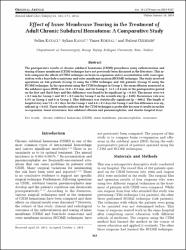Effect of inner membrane tearing in the treatment of adult chronic subdural hematoma: a comparative study
Citation
Kayaci, S., Kanat, A., Koksal, V., Ozdemir, B., (2014).Effect of Inner Membrane Tearing in the Treatment of Adult Chronic Subdural Hematoma: A Comparative Study.Neurologia Medico-Chirurgica, 54(5), 363-373.https://doi.org/10.2176/nmc.oa.2013-0147Abstract
The postoperative results of chronic subdural hematoma (CSDH) procedures using catheterization and tearing of inner membrane (CTIM) technique have not previously been discussed in the literature. This article compares the effects of CTIM technique on brain re-expansion and re-accumulation with cases operated on with a burr-hole craniotomy and outer membrane incision (BCOMI) technique. the study involved operations on 144 patients (Group 1) using the CTIM technique and 108 patients (Group 2) using the BCOMI technique. in the operations using the CTIM technique in Group 1, the mean effusion measured in the subdural space (SDS) was 10.0 +/- 0.2 mm, and for Group 2, 14.3 +/- 0.6 mm in the postoperative period on the first and third days and this difference was found to be significant (p < 0.05). the means were 6.6 +/- 0.2 mm for Group 1 and 10.3 +/- 0.5 mm for Group 2 on the seventh day (p < 0.05). Recurrence rate was 8.3% in Group 2 and 0 in Group 1. This difference was statistically significant (p = 0001). the length of hospital stay was 7.0 +/- 0.1 days for the Group 1 and 8.8 +/- 0.2 days for Group 2 and this difference was significant (p < 0.05). These results indicate that the CTIM technique is preferable because it results in earlier re-expansion, lower recurrence, less subdural effusion and pneumocephalus, and shorter hospital stays.


















